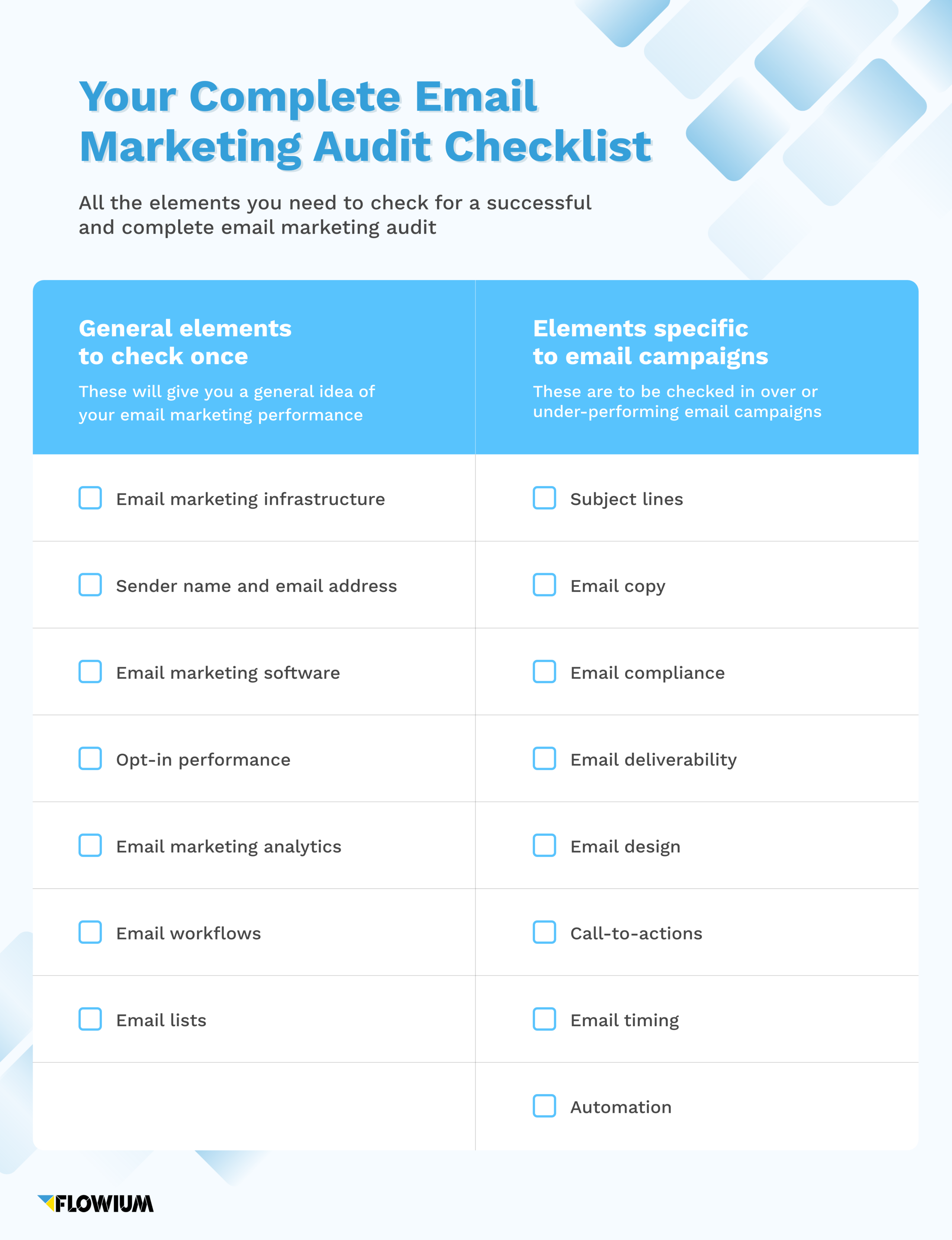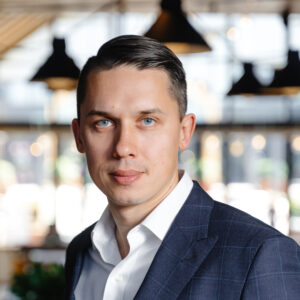With so many moving parts involved in email marketing, getting it right can be tricky. This is why many business owners give up on their email marketing efforts too quickly, thinking that email marketing simply isn’t effective anymore.
This can’t be further from the truth. According to recent statistics, email marketing has an average ROI of $40 for every $1 spent, making it one of the most cost-effective and profitable marketing strategies you can invest in.
So, if you’re among those struggling with failed email marketing campaigns, it’s time to take a closer look at your strategy by conducting an email marketing audit.
In this guide, we’ll share everything you need to know about email marketing audits: what they are, why they’re important, and – most of all – how to conduct one.
What Is an Email Marketing Audit and Why Is It Important
The word “audit” may send shivers down your spine. After all, we associate auditing with a stressful corporate activity designed to pinpoint all of our mistakes and flaws.
But despite its dreadful meaning, conducting audits is crucial to making sure that everything is moving smoothly toward the initially set goal. And if it isn’t, audits are the most efficient method for identifying potential issues and finding a way to improve them.
The same applies to email marketing audits. While it may be time-consuming and tedious, conducting an email marketing audit is essential to ensure your email marketing efforts are hitting the mark.
So, let’s define what email marketing audits are.
Defining email marketing audits
Simply said, an email marketing audit is an examination of the performance of your email marketing strategy. It’s meant to identify its strengths and weaknesses and find opportunities for improvement.
Holistically speaking, the goal of an email audit is to optimize the health of your email marketing strategy as a whole.
Numerically speaking, the goal of an email audit is to help you improve your key email marketing metrics, such as the open, click, and conversion rates.
Practically speaking, an email marketing audit means crunching the numbers, analyzing the stats, and creating a cohesive outlook of your entire email marketing strategy that effectively pinpoints its strengths and flaws.
This comes down to:
- Evaluating the metrics of your email campaigns,
- Analyzing your list segmentation tactics,
- Reviewing the contents and design of your email campaigns,
- Understanding what works and what doesn’t.
Email marketing audit goals
When you’re focused on the details of your most recent email campaign, conducting an audit often means taking a step back to re-focus on the big picture.
Some of the most common goals of email marketing audits are:
1️⃣ Improving email deliverability
An email audit can help you ensure that emails are successfully landing in your subscribers’ inboxes. It can identify issues with email authentication, spam filters, and email list hygiene that may be sending your emails into people’s spam folders or the internet void.
2️⃣ Optimizing email performance metrics
Another goal of an email audit is to identify areas where your email campaigns are underperforming. It can help you understand what’s causing unfavorable metrics, such as low conversion rates or high unsubscribe rates.
On the other hand, it can also help you figure out how to improve engagement rates (such as open and click-through rates) by analyzing where the contents and design of your email campaigns fall short.
3️⃣ Ensuring compliance with relevant regulations
An email marketing audit can help you keep up with relevant privacy regulations, such as GDPR and CCPA, and ensure that your company is complying with them.
It can identify issues with email list hygiene, opt-in processes, and unsubscribe procedures that may be violating these regulations.
How to Audit Emails – 6 Steps of an Email Marketing Audit
Now that you know how important email marketing audits are to the success of the email marketing strategy, you might want to know how to actually conduct one.
Let’s break it down into 6 steps.

Define your goals
Before you start conducting your audit, it’s essential to define its goals. What are you looking to achieve?
Here, it’s important to know that there are various types of email marketing audits.
You can conduct a general one that aims to check the health of your overall strategy or a more detailed one that focuses on one specific area of your strategy.
Some email marketing audit types are:
- Performance audit,
- Deliverability audit,
- Content audit,
- Design audit,
- Automation audit,
- List segmentation audit,
- Compliance audit.
📌 Once you decide on the type of audit you want to undertake, make a list of the goals you want it to achieve. This will help you put your focus on attaining these goals.
Define your KPIs
Defining your Key Performance Indicators (KPIs) is essential to measure the performance of your email campaigns effectively.
Once you’ve defined the goals you want to achieve with your audit, choose the most relevant metrics to track and set realistic targets for each metric.
Here are some KPIs you can select for your audit:
- Open rate
- Click-through rate
- Conversion rate
- Unsubscribe rate
- Spam complaint rate
- ROI of email campaigns
- Number of email campaigns sent and delivered
Start a spreadsheet
The overall goal of an email marketing audit is to optimize and improve your email marketing strategy.
In reality, it comes down to evaluating each campaign, focusing on each stat, and analyzing how it all ties together. You need to be able to assess how each aspect of your campaign contributed to its overall success — or lack thereof.
Creating a spreadsheet will help you keep track of all the relevant information about your email campaigns. It’ll also give you a place to store the results of your analysis so that you can refer back to them when necessary.
You may want to prepare a spreadsheet with dedicated columns to track things like:
- Campaign name,
- Subject line,
- Audience segment,
- Open rate,
- Click-through rate (CTR),
- Unsubscribe rate.
💡 Doing this will allow you to compare different aspects of every campaign side by side and see how they compare with one another, creating a cohesive outlook on your results.
Collect and organize data
Now that you have a spreadsheet set up, it’s time to populate it with numbers by pulling data from your email marketing tool and teammates.
After organizing the data in the spreadsheet, compare the metrics against industry benchmarks, past performance, and goals to identify where your email marketing strategy is doing well and where it needs improvement.
On the flip side, analyzing and comparing campaign data may reveal that some things are working great! Having this information can help you build on what works.
Find out why some emails or campaigns are performing better or worse than others
The next step of the email marketing audit process involves a deep analysis and comparison of the results of your campaigns.
It’s important to view your email marketing from both the negative and positive sides. Zoom into the bad and good results. This way, you’ll be able to figure out what’s working – so you can keep doing it in the future – and what’s not working – so you can improve it.
To do this, it’s essential to closely examine all the different parts of your email marketing strategy. Use the checklist in the next section of this article to do this more effectively.
Draw conclusions and act accordingly
The last step of conducting an email marketing audit is compiling your findings into an easy-to-understand report you’ll send to your entire email marketing team.
This report needs to summarize the most important conclusions from your audit, along with recommended changes and a plan of action to improve the performance of your email marketing strategy.
Once your entire email marketing team is familiar with the results of the audit, it’s time to start implementing changes by assigning specific tasks to your employees.
📌 As you start experimenting with new ideas, make sure to A/B test the results of these changes and observe how your subscribers react to them.
General Email Marketing Audit Checklist
If you’re considering running an email audit, it’s crucial to have a clear checklist to guide you through the process.
In this section, we’ll be delving into the general email marketing audit checklist. The elements on this checklist should only be checked once, at the beginning of your audit.
Email marketing infrastructure
The first thing you need to check is your email marketing infrastructure. This refers to the technical aspects of your email marketing strategy, such as:
- Authentication protocols: Email authentication protocols like DKIM, SPF, and DMARC verify email authenticity and prevent fraud and phishing attacks.
- SMTP server: The Simple Mail Transfer Protocol (SMTP) server is responsible for sending your emails.
- DNS records: DNS records are used to map domain names to IP addresses.
- Feedback loops: Feedback loops can help you identify issues with your email content or frequency that may be causing subscribers to complain or mark your emails as spam.
To improve the health of your email campaigns, ensure that all of these elements are configured correctly.
Sender name and email address
Your sender name and email address contribute to the success or failure of your email campaigns.
No one trusts emails from a fishy-looking email address or sender name. Make sure they’re recognizable and trustworthy. Use a professional email address that includes your brand name, such as in**@*******me.com or similar.
📌 Also, avoid using a no-reply email address if possible. No reply addresses make you seem unapproachable and disinterested.
Email marketing software
Choosing the wrong email marketing software can set up your entire email marketing strategy for failure.
An email marketing audit is a great opportunity to evaluate whether you’re satisfied with your current email marketing software and whether it aligns with your needs and budget.
📌 Make sure that your email marketing provider offers all the features you need, is up-to-date with the latest technology, and doesn’t glitch too often. If you happen to identify potential issues, it might be worth considering switching providers.
Opt-in performance
Opt-in forms are crucial for growing your email list and reaching potential customers, so it’s important to evaluate how they’re performing.
You should review things like:
- The placement of your opt-in forms on your website and landing pages,
- The design of your opt-in forms,
- The messaging of your opt-in forms, including the headlines and the calls-to-action,
- The incentive you offer for signing up to your email list.
These elements will contribute to the conversion rate of each form. Evaluate whether the conversion rates are hitting the goal. If not, analyze potential areas for improvement.
Email marketing analytics
Of course, the effectiveness of your email marketing campaigns is based on relevant metrics, so it’s important to ensure that this data is accurate.
💡 Any potential errors in data can result in poor decisions and ultimately hinder the success of your overall email marketing strategy.
Make sure that your email marketing analytics are properly set up and that the data is being collected accurately.
Email workflows
A poorly structured workflow can result in mistakes, delays, and missed opportunities. An email audit is a perfect opportunity to analyze your workflows and processes to make them more efficient.
When analyzing your email workflows, answer the following questions:
- Is the workflow streamlined and easy to follow?
- Does everyone involved in the process have access to all the necessary information?
- Is the workflow documented and easily accessible to everyone?
- Are there any inefficiencies in the workflow?
- Is there a straightforward process for testing and approving emails before they are sent?
By addressing these questions, you can identify areas where the workflow can be improved.
Email lists
Your email list is the foundation of your email marketing strategy. If it’s not segmented correctly or contains invalid or inactive email addresses, it will negatively impact your email marketing efforts.
Analyzing the quality of your email list will allow you to remove invalid email addresses, identify spam traps, and maintain a clean list.
Once you’ve verified the quality of your email list, take a closer look at your audience segmentation. Ask yourself whether your current segmentation is bringing the expected results. If it’s not, it may be time to switch things up!

Email Marketing Audit Checklist Focusing on Email Campaigns
Your email campaigns are at the heart of any successful email marketing strategy, so it’s essential to include a thorough analysis of your campaigns as part of your email marketing audit.
Here’s an email marketing audit checklist focused specifically on email campaigns. The elements included on this checklist should be evaluated for every campaign that forms part of your audit, or at least for every email campaign that stands out in your audit by over or under-performing.
Let’s get started.
Subject lines
If your email campaigns get low open rates, you should reevaluate two key campaign aspects: the subject line and pre-header text.
Ask yourself the following questions:
- Are some subject lines consistently outperforming others?
- Are there any subject lines that consistently underperform?
- Does my pre-header text contribute to my campaign, or is it completely irrelevant?
- Are the subject lines and pre-header text clear and concise?
- Do they accurately reflect the content of your email
- Are they attention-grabbing and compelling?
After you identify the issues with your subject lines and pre-header text, come up with new ideas based on your conclusions. Then, A/B test them to see which variations perform best.
Email copy
The email copy is the core of your email campaign and directly impacts engagement and conversion rates. In short, your email copy can make or break your campaign.
Review the copy of your emails to identify the trends and patterns that result in the highest and lowest conversion rates.
This will help you understand what works and what doesn’t – and come up with ideas on how to improve the copy of your campaigns.
Email compliance
Email compliance violations can result in significant consequences, such as email deliverability issues, legal disputes, and damage to your brand’s reputation.
Evaluating compliance involves reviewing your email marketing practices to ensure they align with regulations, such as the CAN-SPAM Act in the United States and GDPR in the European Union.
This includes verifying that you have obtained proper consent from subscribers to receive your emails, providing an easy way to unsubscribe, and including accurate sender information.
Email deliverability
Email deliverability refers to the ability of your emails to reach your subscribers’ inboxes successfully.
An email marketing audit can help you evaluate the deliverability rate of your email campaigns and pinpoint any factors that result in a failure to deliver your emails, such as spam filters or IP issues.
Email design
Your email design can significantly impact how your subscribers engage with your brand and the likelihood of them taking action, such as clicking through to your website or making a purchase.
Analyzing the design patterns and trends in your emails as part of your email marketing audit can help you identify what works and what doesn’t, allowing you to optimize your email campaigns for better results.
Some elements that contribute to poor design you might identify in your campaigns are:
- Overcrowded layout,
- Too much text,
- Poor use of color,
- Lack of mobile optimization,
- Inconsistent branding,
- Too many or irrelevant images.
Call-to-actions
An email without a call to action is like a car without a steering wheel – it might look good, but it’s not going anywhere! Just as a steering wheel is essential for driving a car, a call to action is necessary for driving action from your email subscribers.
Analyze the design, the copy, the placement, and the relevance of your CTAs to figure out which CTAs perform better or worse than others and why.
Email timing
Timing is everything in email marketing. If your timing isn’t right, it can ruin the success of your campaigns – even if everything else is on point.
💡 Sending too many emails can cause email fatigue and cause people to unsubscribe. Sending too few emails can result in low engagement or being forgotten by your subscribers.
Conducting an email marketing audit allows you to find the frequency sweet spot and analyze which send times perform best for specific campaign times.
Automation
While automated email campaigns are a great way to optimize your email marketing efforts, many marketers set them and forget them.
But, neglecting to review your automated campaigns periodically can lead to errors in your emails, which can negatively impact your subscribers’ experience and hurt your brand image.
That’s why evaluating your automated email campaigns is an essential part of your email marketing audit.
Regularly auditing your automated campaigns can also help you identify opportunities to improve their effectiveness.
Frequently Asked Questions about Email Marketing Audits
Anyone with experience in email marketing best practices can conduct an email marketing audit. You can do it yourself, delegate it to your in-house email marketing team, or hire a professional agency. The right choice for you will depend on your resources, budget, and the complexity of your email marketing program.
You can perform an email marketing audit at the end of the year, in the middle of the year, or even after each quarter – it depends entirely on your needs. The rule of thumb is to conduct an audit regularly, at least once a year.
The time it takes to perform an email marketing audit varies depending on the complexity of your program, the amount of data to analyze, and the type and scope of the audit. A basic audit of one single email campaign can take a few hours, while a comprehensive audit of your entire email marketing strategy can take a few weeks.







